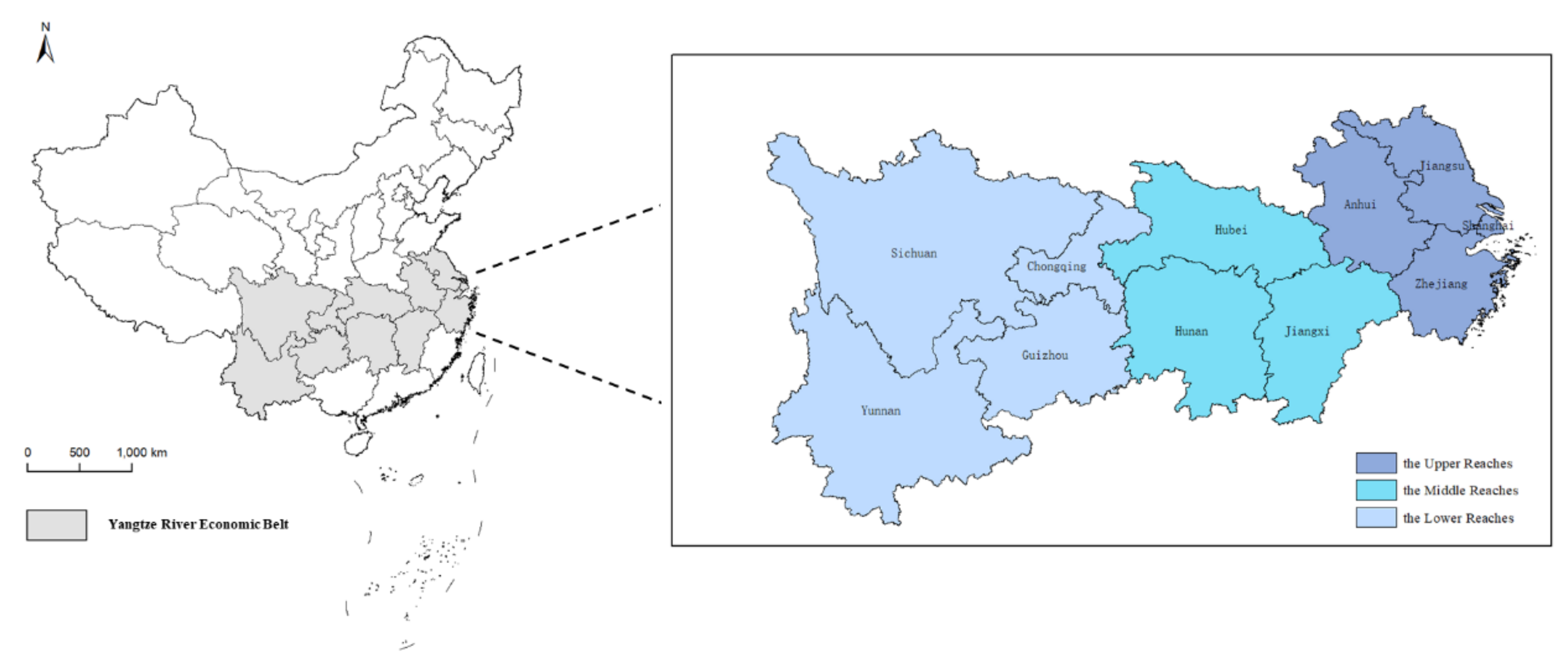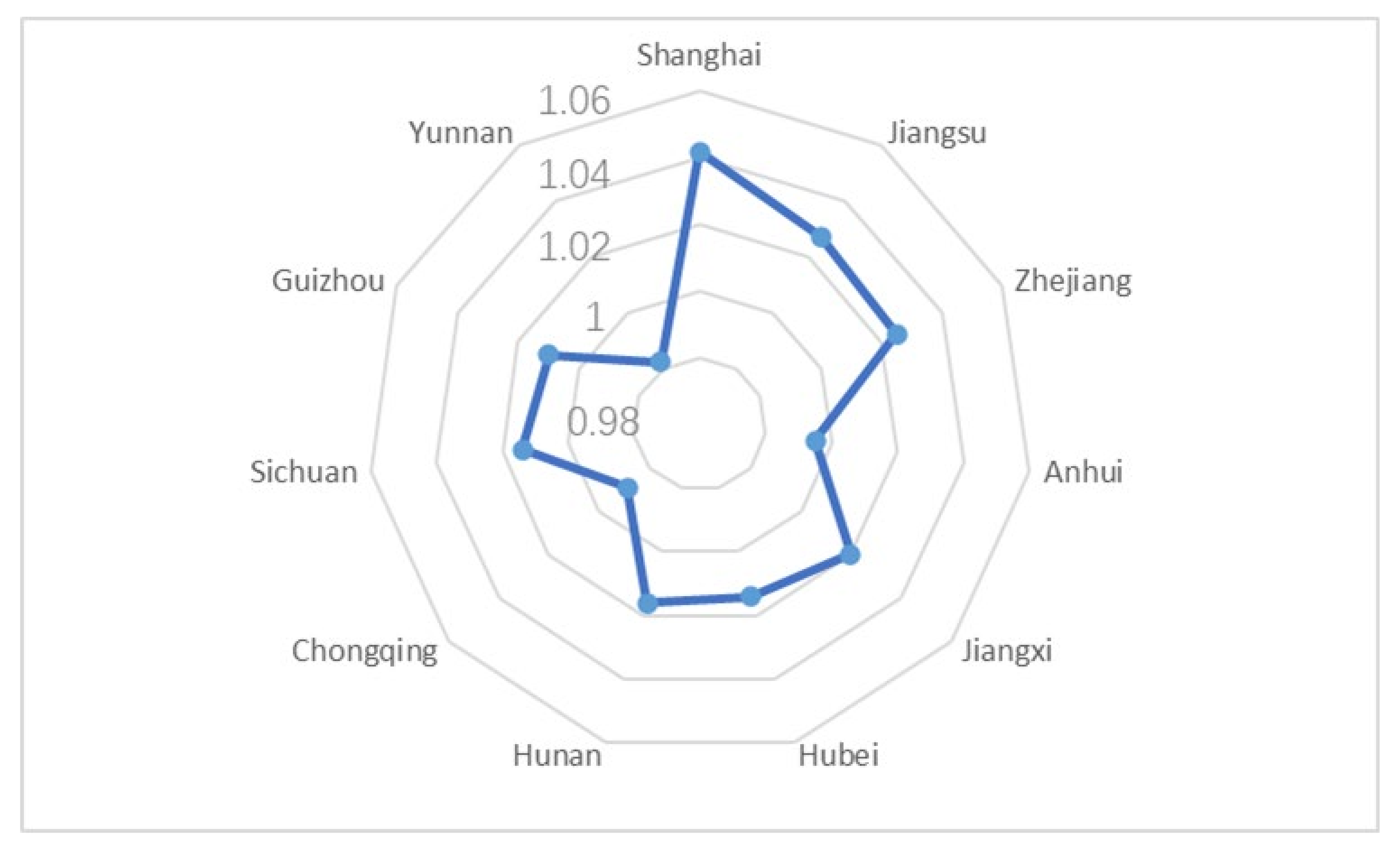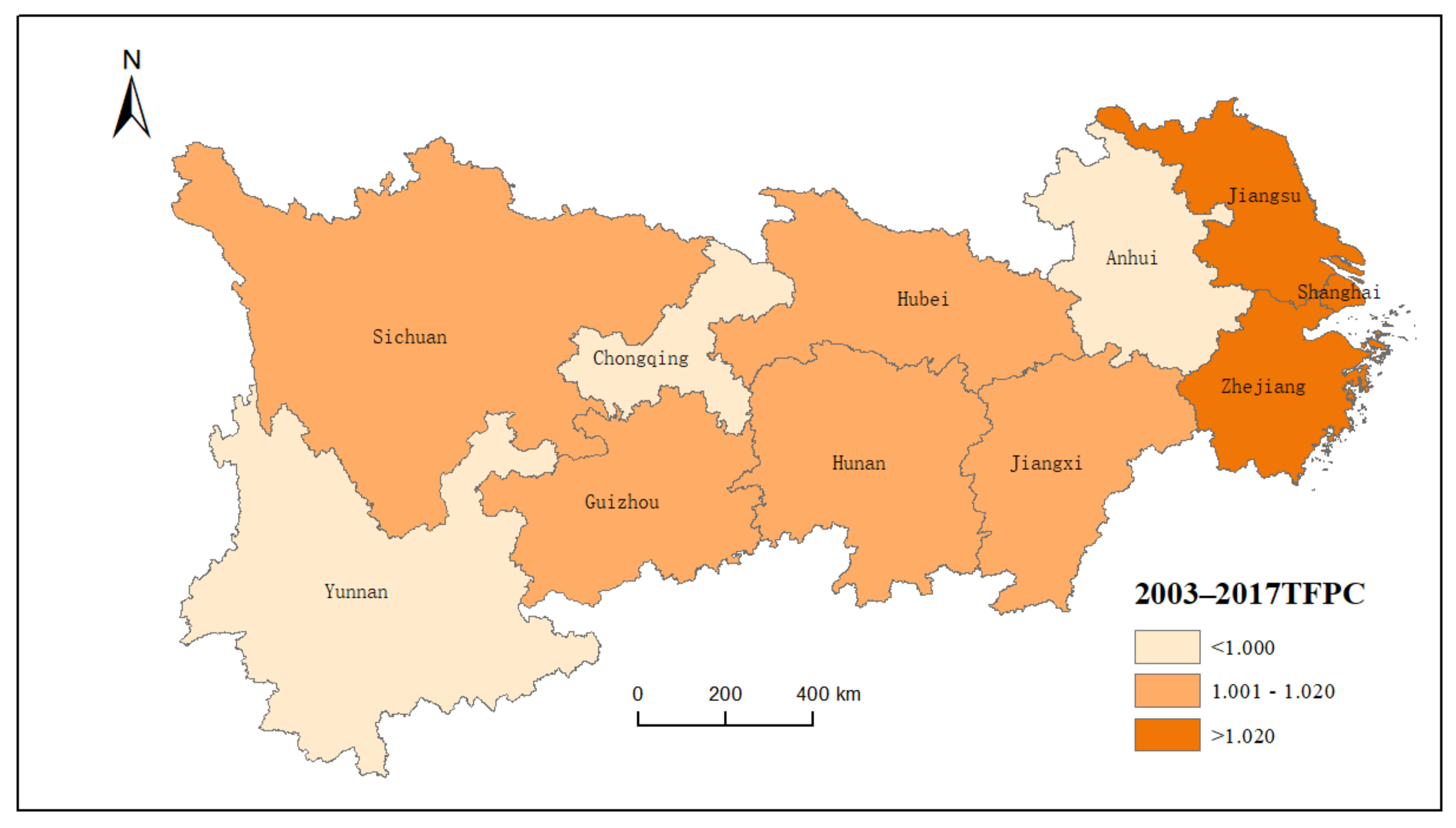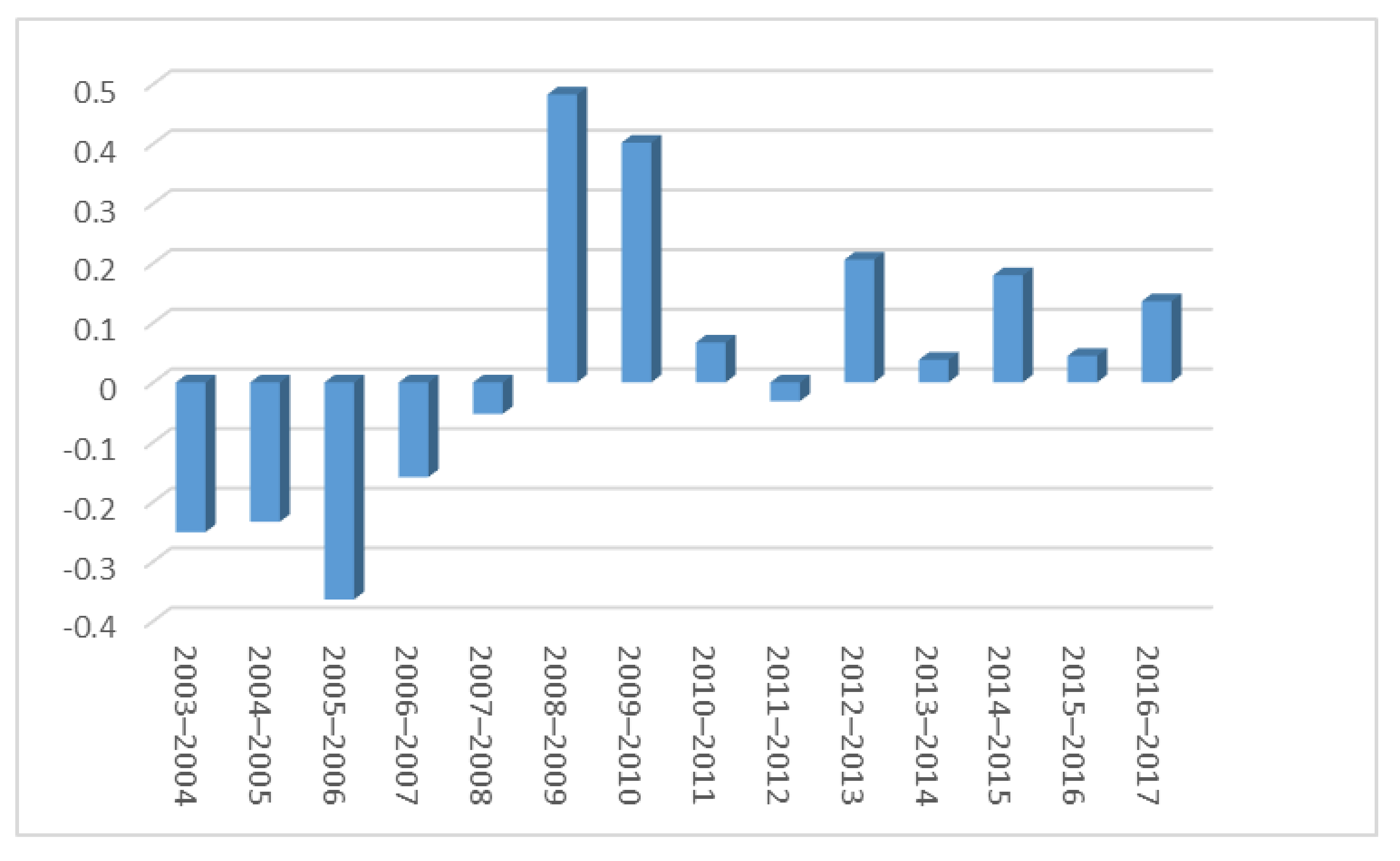Spatial-Temporal Evolution of Total Factor Productivity in Logistics Industry of the Yangtze River Economic Belt, China
Abstract
:1. Introduction
2. Methodology and Data
2.1. DEA-Malmquist Model
2.2. Exploratory Spatial Data Analysis (ESDA) Model
2.2.1. Global Spatial Autocorrelation Analysis
2.2.2. Local Spatial Autocorrelation Analysis
2.3. Study Area
2.4. Variables and Data Description
3. Results and Discussions
3.1. Spatial-Temporal Evolution of LITFP in the YREB
3.1.1. Time Evolution of LITFP in the YREB
3.1.2. Spatial Evolution of LITFP in the YREB
3.2. Spatial Autocorrelation Analysis of LITFP in the YREB
3.2.1. Global Spatial Autocorrelation Analysis of LITFP in the YREB
3.2.2. Local Spatial Autocorrelation Analysis of LITFP in the YREB
4. Conclusions and Policy Implications
Author Contributions
Funding
Institutional Review Board Statement
Informed Consent Statement
Data Availability Statement
Conflicts of Interest
References
- Deng, F.; Xu, L.; Fang, Y.; Gong, Q.; Li, Z. PCA-DEA-Tobit Regression Assessment with Carbon Emission Constraints of China’s Logistics Industry. J. Clean. Prod. 2020, 271, 122548. [Google Scholar] [CrossRef]
- Yu, L.; Shi, M.; Li, J. Logistics efficiency and factor decomposition of the Yangtze River Economic Belt based on DEA-Malmquist index model. Bus. Econ. Manag. 2018, 4, 16–25. (In Chinese) [Google Scholar] [CrossRef]
- State Council the People’s Republic of China. Medium and Long Term Planning of Logistics Development (2014–2020). 2014. Available online: http://www.gov.cn/zhengce/content/2014-10/04/content_9120.htm (accessed on 5 January 2022).
- Liang, Z.; Chiu, Y.; Guo, Q.; Liang, Z. Low-Carbon Logistics Efficiency: Analysis on the Statistical Data of the Logistics Industry of 13 Cities in Jiangsu Province, China. Res. Transp. Bus. Manag. 2021, 100740. [Google Scholar] [CrossRef]
- Liu, W.; Liang, Y.; Bao, X.; Qin, J.; Lim, M.K. China’s Logistics Development Trends in the Post COVID-19 Era. Int. J. Logist. Res. Appl. 2020, 1, 1–12. [Google Scholar] [CrossRef]
- Tian, X.; Zhang, M. Research on Spatial Correlations and Influencing Factors of Logistics Industry Development Level. Sustainability 2019, 11, 1356. [Google Scholar] [CrossRef] [Green Version]
- Zuo, Z.; Guo, H.; Li, Y.; Cheng, J. A Two-Stage DEA Evaluation of Chinese Mining Industry Technological Innovation Efficiency and Eco-Efficiency. Environ. Impact Assess. Rev. 2022, 94, 106762. [Google Scholar] [CrossRef]
- Xu, X.; Huang, X.; Huang, J.; Gao, X.; Chen, L. Spatial-temporal characteristics of agriculture green total factor productivity in China, 1998–2016: Based on more sophisticated calculations of carbon emissions. Int. J. Environ. Res. Public Health 2019, 16, 3932. [Google Scholar] [CrossRef] [Green Version]
- Li, M.; Wang, J. Spatial-temporal evolution and influencing factors of total factor productivity in China’s logistics industry under low-carbon constraints. Environ. Sci. Pollut. Res. 2022, 29, 883–900. [Google Scholar] [CrossRef]
- Baldoni, E.; Coderoni, S.; Esposti, R. The productivity and environment nexus with farm-level data. The Case of Carbon Footprint in Lombardy FADN farms. Bio-Based Appl. Econ. 2017, 6, 119–137. [Google Scholar] [CrossRef]
- Baldoni, E.; Coderoni, S.; Esposti, R. The Complex Farm-Level Relationship between Environmental Performance and Productivity. The Case of Carbon Footprint of Lombardy farms. Environ. Sci. Policy 2018, 89, 73–82. [Google Scholar] [CrossRef]
- Wu, S.; Walker, D.; Devadoss, S. Productivity Growth and its Component in Chinese Agriculture after Reforms. Rev. Dev. Econ. 2001, 5, 375–391. [Google Scholar] [CrossRef] [Green Version]
- Lambert, D.K.; Parker, E. Productivity in Chinese Provincial Agriculture. J. Agric. Econ. 2010, 49, 378–392. [Google Scholar] [CrossRef]
- Wu, D. Impact of Green Total Factor Productivity in Marine Economy Based on Entropy Method. Pol. Marit. Res. 2018, 25, 141–146. [Google Scholar] [CrossRef] [Green Version]
- Bayarsaihan, T.; Coelli, T. Productivity growth in pre-1990 Mongolian agriculture: Spiraling disaster or emerging success. Agric. Econ. 2003, 28, 121–137. [Google Scholar]
- Guo, P.; Qi, X.; Zhou, X.; Li, W. Total-factor energy efficiency of coal consumption: An empirical analysis of China’s energy intensive industries. J. Clean. Prod. 2018, 172, 2618–2624. [Google Scholar] [CrossRef]
- Han, H.; Zhong, Z.; Wen, C.; Sun, H. Agricultural environmental total factor productivity in China under technological heterogeneity: Characteristics and determinants. Environ. Sci. Pollut. Res. 2018, 25, 32096–32111. [Google Scholar] [CrossRef]
- Zhang, Y.; Wu, Z. Intelligence and green total factor productivity based on China’s province-level manufacturing data. Sustainability 2021, 13, 4989. [Google Scholar] [CrossRef]
- Li, W.; Wang, W.; Wang, Y.; Ali, M. Historical growth in total factor carbon productivity of the Chinese industry—A comprehensive analysis. J. Clean. Prod. 2018, 170, 471–485. [Google Scholar] [CrossRef]
- Markovits-Somogyi, R.; Bokor, Z. Assessing the Logistics Efficiency of European Countries by Using the DEA-PC Methodology. Transport 2014, 29, 137–145. [Google Scholar] [CrossRef] [Green Version]
- Xu, S. Study on the Logistics Efficiency of Three Northeast Provinces Based on Three-Stage DEA. In Proceedings of the International Conference on Information Computing and Applications, Chengde, China, 14–16 September 2012; Liu, C., Wang, L., Yang, A., Eds.; Springer: Berlin/Heidelberg, Germany, 2012; pp. 810–819. [Google Scholar]
- Wong, W.P.; Soh, K.L.; Goh, M. Innovation and productivity: Insights from Malaysia’s logistics industry. Int. J. Log. Res. Appl. 2016, 19, 318–331. [Google Scholar] [CrossRef]
- Lan, S.L.; Tseng, M.L.; Chen, Y.; Donald, H. Trends in sustainable logistics in major cities in China. Sci. Total Environ. 2020, 712, 136381. [Google Scholar] [CrossRef]
- Petiot, R.; Dumas, A.; Cavaignac, L. Third-party logistics efficiency: An innovative two-stage DEA analysis of the French market. Int. J. Logs 2020, 3, 581–604. [Google Scholar]
- He, D.; Yang, J.; Wang, Z.; Li, W. Has the Manufacturing Policy Helped to Promote the Logistics Industry? PLoS ONE 2020, 15, e0235292. [Google Scholar] [CrossRef]
- Nguyen, N.T.; Tran, T.T. Raising opportunities in strategic alliance by evaluating efficiency of logistics companies in Vietnam: A case of Cat Lai Port. Neural Comput. Appl. 2019, 31, 7963–7974. [Google Scholar] [CrossRef]
- Park, H.G.; Lee, Y.J. The Efficiency and Productivity Analysis of Large Logistics Providers Services in Korea. Asian J. Shipp. Logist. 2015, 31, 469–476. [Google Scholar] [CrossRef] [Green Version]
- Zhu, W.; Zhu, Y.; Yu, Y. China’s regional environmental efficiency evaluation: A dynamic analysis with biennial Malmquist productivity index based on common weights. Environ. Sci. Pollut. Res. 2020, 27, 39726–39741. [Google Scholar] [CrossRef]
- Huang, B.; Zhang, L.; Ma, L.; Bai, W.; Ren, J. Multi-criteria decision analysis of China’s energy security from 2008 to 2017 based on Fuzzy BWM-DEA-AR model and Malmquist Productivity Index. Energy 2021, 228, 120481. [Google Scholar] [CrossRef]
- Liu, Z.K.; Jiang, Y.F.; Bolayog, D. Does “replacing business tax with value-added tax” promote the energy efficiency of the logistics industry in China? Environ. Sci. Pollut. Res. 2019, 26, 33169–33180. [Google Scholar] [CrossRef]
- Liang, Z.G.; Chiu, Y.H.; Li, X.C.; Guo, Q.; Yun, Y. Study on the effect of environmental regulation on the green total factor productivity of logistics industry from the perspective of low carbon. Sustainability 2020, 12, 175. [Google Scholar] [CrossRef] [Green Version]
- Long, R.; Ouyang, H.; Guo, H. Super-Slack-Based Measuring Data Envelopment Analysis on the Spatial-Temporal Patterns of Logistics Ecological Efficiency Using Global Malmquist Index Model. Environ. Technol. Innov. 2020, 18, 100770. [Google Scholar] [CrossRef]
- Tan, L.L.; Wu, Q.Q.; Li, Q.; Cheng, W.; Gu, Y.L. A panel analysis of the sustainability of logistics industry in China: Based on non-radial slacks-based method. Environ. Sci. Pollut. Res. 2019, 26, 21948–21963. [Google Scholar] [CrossRef]
- Peng, Z.M.; Wu, Q.Q.; Wang, D.F.; Li, M. Temporal-spatial pattern and influencing factors of China’s province-level transport sector carbon emissions efficiency. Pol. J. Environ. Stud. 2020, 29, 233–247. [Google Scholar] [CrossRef]
- Charnes, A.; Cooper, W.W.; Rhodes, E. Measuring the Efficiency of Decision Making Units. Eur. J. Oper. Res. 1978, 2, 429–444. [Google Scholar] [CrossRef]
- Li, Y.; Zuo, Z.; Xu, D.; Wei, Y. Mining Eco-Efficiency Measurement and Driving Factors Identification Based on Meta-US-SBM in Guangxi Province, China. Int. J. Environ. Res. Public Health 2021, 18, 5397. [Google Scholar] [CrossRef]
- Chen, C.-M.; van Dalen, J. Measuring Dynamic Efficiency: Theories and an Integrated Methodology. Eur. J. Oper. Res. 2010, 203, 749–760. [Google Scholar] [CrossRef]
- Asmild, M.; Paradi, J.C.; Reese, D.N.; Tam, F. Measuring Overall Efficiency and Effectiveness Using DEA. Eur. J. Oper. Res. 2007, 178, 305–321. [Google Scholar] [CrossRef]
- Xu, Z.; Zhu, X.; Wei, G.; Ouyang, X. Spatio-Temporal Evolution and Mechanism Analysis of China’s Regional Innovation Efficiency. Sustainability 2021, 13, 11089. [Google Scholar] [CrossRef]
- Xu, Z.; Yin, Y. Regional Development Quality of Yangtze River Delta: From the Perspective of Urban Population Agglomeration and Ecological Efficiency Coordination. Sustainability 2021, 13, 12818. [Google Scholar] [CrossRef]
- Li, H.; Qu, J.; Wang, D.; Meng, P.; Lu, C.; Zeng, J. Spatial-Temporal Integrated Measurement of the Efficiency of Urban Land Use in Yellow River Basin. Sustainability 2021, 13, 8902. [Google Scholar] [CrossRef]
- Yi, L.; Liu, Y.; Li, Z.; Yang, L.; Wang, F. Study on Serviceability and Efficiency of Seven Pilot Carbon Trading Exchanges in China. Sci. Total Environ. 2020, 703, 135465. [Google Scholar] [CrossRef]
- Chang, K.; Wan, Q.; Lou, Q.; Chen, Y.; Wang, W. Green Fiscal Policy and Firms’ Investment Efficiency: New Insights into Firm-Level Panel Data from the Renewable Energy Industry in China. Renew. Energy 2020, 151, 589–597. [Google Scholar] [CrossRef]
- Lombardi, G.V.; Stefani, G.; Paci, A.; Becagli, C.; Miliacca, M.; Gastaldi, M.; Giannetti, B.F.; Almeida, C.M.V.B. The Sustainability of the Italian Water Sector: An Empirical Analysis by DEA. J. Clean. Prod. 2019, 227, 1035–1043. [Google Scholar] [CrossRef]
- Malmquist, S. Index Numbers and Indifference Surfaces. Trab. Estad. 1953, 4, 209–242. [Google Scholar] [CrossRef]
- Caves, D.W.; Christensen, L.R.; Diewert, W.E. The Economic Theory of Index Numbers and the Measurement of Input, Output, and Productivity. Econometrica 1982, 50, 1393–1414. [Google Scholar] [CrossRef]
- Färe, R.; Grosskopf, S.; Lindgren, B.; Roos, P. Productivity Changes in Swedish Pharamacies 1980–1989: A Non-Parametric Malmquist Approach. J. Prod. Anal. 1992, 3, 85–101. [Google Scholar] [CrossRef]
- Färe, R.; Grosskopf, S.; Norris, M.; Zhang, Z. Productivity Growth, Technical Progress, and Efficiency Change in Industrialized Countries. Am. Econ. Rev. 1994, 84, 66–83. [Google Scholar]
- Ray, S.C.; Desli, E. Productivity Growth, Technical Progress, and Efficiency Change in Industrialized Countries: Comment. Am. Econ. Rev. 1997, 87, 1033–1039. [Google Scholar]
- De Siano, R.; D’Uva, M. Do Spatial Interdependencies Matter in Italian Regional Specialization? Geogr. Anal. 2014, 46, 185–208. [Google Scholar] [CrossRef]
- Li, X.; Griffin, W.A. Using ESDA with Social Weights to Analyze Spatial and Social Patterns of Preschool Children’s Behavior. Appl. Geogr. 2013, 43, 67–80. [Google Scholar] [CrossRef]
- Xie, Z.; Qin, Y.; Li, Y.; Shen, W.; Zheng, Z.; Liu, S. Spatial and Temporal Differentiation of COVID-19 Epidemic Spread in Mainland China and Its Influencing Factors. Sci. Total Environ. 2020, 744, 140929. [Google Scholar] [CrossRef]
- Wang, K.; Zhao, X.; Peng, B.; Zeng, Y. Spatio-Temporal Pattern and Driving Factors of Municipal Solid Waste Generation in China: New Evidence from Exploratory Spatial Data Analysis and Dynamic Spatial Models. J. Clean. Prod. 2020, 270, 121794. [Google Scholar] [CrossRef]
- Wang, S.; Liu, H.; Pu, H.; Yang, H. Spatial Disparity and Hierarchical Cluster Analysis of Final Energy Consumption in China. Energy 2020, 197, 117195. [Google Scholar] [CrossRef]
- Yang, J.; Tang, L.; Mi, Z.; Liu, S.; Li, L.; Zheng, J. Carbon Emissions Performance in Logistics at the City Level. J. Clean. Prod. 2019, 231, 1258–1266. [Google Scholar] [CrossRef]
- Gong, Y.; Yang, X.-Q.; Ran, C.-Y.; Shi, V.; Zhou, Y.-F. Evaluation of the Sustainable Coupling Coordination of the Logistics Industry and the Manufacturing Industry in the Yangtze River Economic Belt. Sustainability 2021, 13, 5167. [Google Scholar] [CrossRef]







| Indicator Type | Variable | Unit |
|---|---|---|
| input | employees (X1) | 100 million yuan |
| fixed asset investment (X2) | 10 thousand people | |
| road operating mileage(X3) | 10 thousand km | |
| output | added value (Y1) | 100 million yuan |
| cargo turnover volume(Y2) | 100 million tons·km |
| Year | TFPC | TC | TEC | PEC | SEC |
|---|---|---|---|---|---|
| 2003–2004 | 1.017 | 1.019 | 0.998 | 1.001 | 0.997 |
| 2004–2005 | 0.980 | 1.035 | 0.948 | 0.991 | 0.956 |
| 2005–2006 | 1.056 | 1.035 | 1.020 | 1.003 | 1.016 |
| 2006–2007 | 0.954 | 1.012 | 0.943 | 0.992 | 0.951 |
| 2007–2008 | 0.848 | 0.895 | 0.947 | 0.972 | 0.975 |
| 2008–2009 | 0.854 | 0.886 | 0.965 | 0.943 | 1.023 |
| 2009–2010 | 0.935 | 0.960 | 0.974 | 0.986 | 0.988 |
| 2010–2011 | 0.919 | 0.908 | 1.012 | 1.018 | 0.994 |
| 2011–2012 | 1.017 | 0.981 | 1.037 | 0.970 | 1.070 |
| 2012–2013 | 1.036 | 1.003 | 1.033 | 1.028 | 1.005 |
| 2013–2014 | 1.042 | 1.033 | 1.009 | 1.025 | 0.984 |
| 2014–2015 | 1.042 | 1.012 | 1.030 | 1.020 | 1.009 |
| 2015–2016 | 1.019 | 1.003 | 1.016 | 1.005 | 1.011 |
| 2016–2017 | 0.975 | 0.961 | 1.014 | 1.002 | 1.012 |
| Average | 0.978 | 0.982 | 0.996 | 0.997 | 0.999 |
Publisher’s Note: MDPI stays neutral with regard to jurisdictional claims in published maps and institutional affiliations. |
© 2022 by the authors. Licensee MDPI, Basel, Switzerland. This article is an open access article distributed under the terms and conditions of the Creative Commons Attribution (CC BY) license (https://creativecommons.org/licenses/by/4.0/).
Share and Cite
Mao, Y.; Li, Y.; Xu, D.; Wu, Y.; Cheng, J. Spatial-Temporal Evolution of Total Factor Productivity in Logistics Industry of the Yangtze River Economic Belt, China. Sustainability 2022, 14, 2740. https://doi.org/10.3390/su14052740
Mao Y, Li Y, Xu D, Wu Y, Cheng J. Spatial-Temporal Evolution of Total Factor Productivity in Logistics Industry of the Yangtze River Economic Belt, China. Sustainability. 2022; 14(5):2740. https://doi.org/10.3390/su14052740
Chicago/Turabian StyleMao, Yu, Yonglin Li, Deyi Xu, Yaqi Wu, and Jinhua Cheng. 2022. "Spatial-Temporal Evolution of Total Factor Productivity in Logistics Industry of the Yangtze River Economic Belt, China" Sustainability 14, no. 5: 2740. https://doi.org/10.3390/su14052740
APA StyleMao, Y., Li, Y., Xu, D., Wu, Y., & Cheng, J. (2022). Spatial-Temporal Evolution of Total Factor Productivity in Logistics Industry of the Yangtze River Economic Belt, China. Sustainability, 14(5), 2740. https://doi.org/10.3390/su14052740





